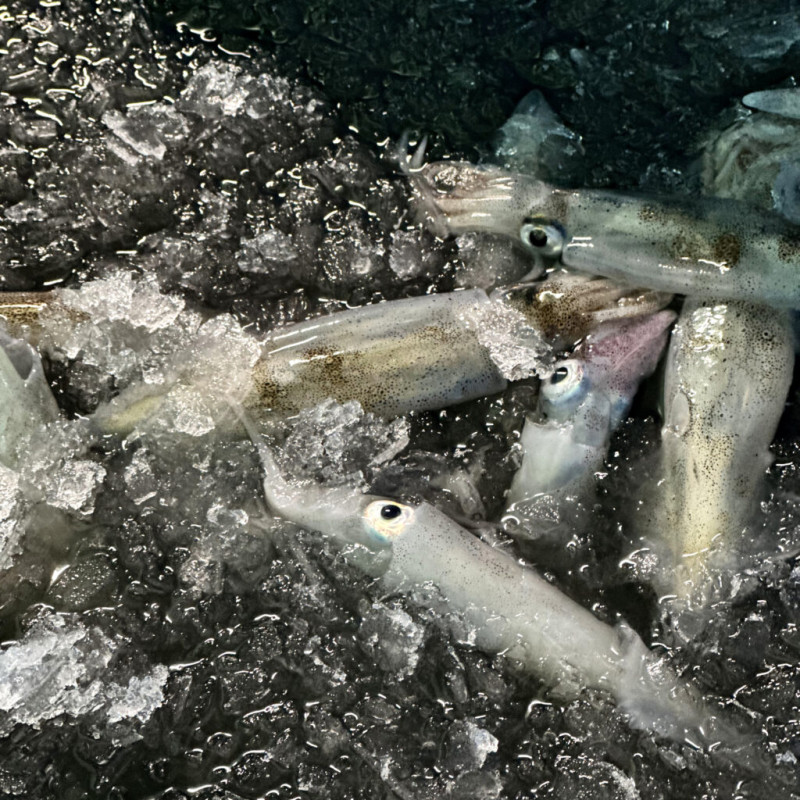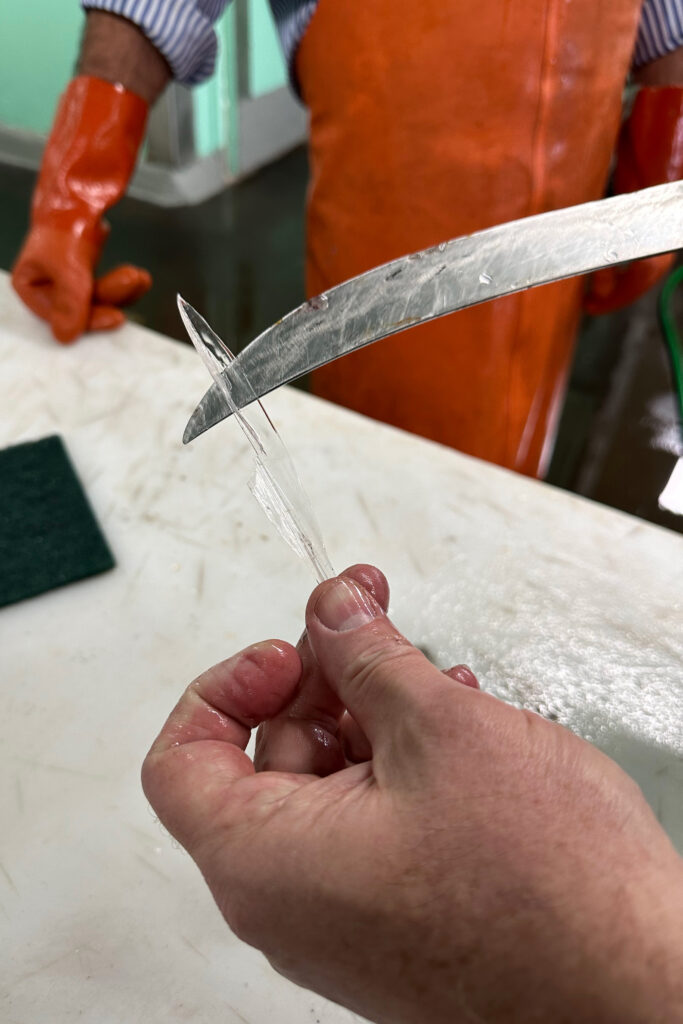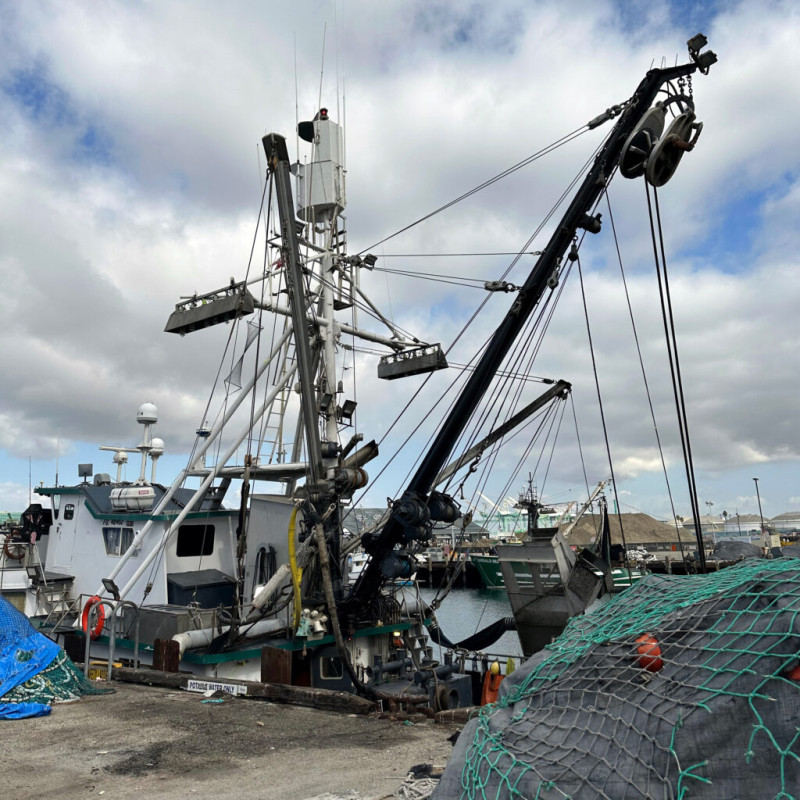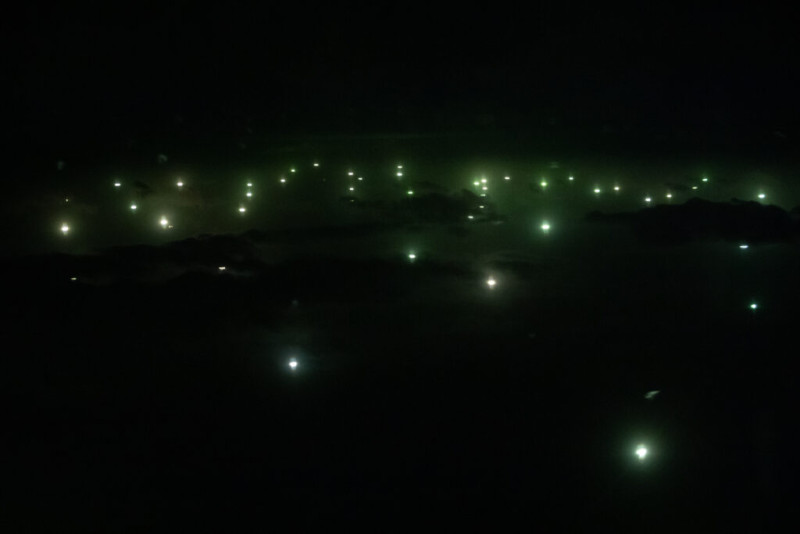Deemed Sustainable by Seafood Industry Monitors, Harvested California Squid Has an Unmeasurable Energy Footprint
This story is being published as part of an international collaboration between news outlets led by The Outlaw Ocean Project, a nonprofit journalism organization based in Washington, D.C. The first story, published by The New Yorker, is here.
Pacific Grove, Calif.— In the middle of the 19th century, off a curve of rocky coast along Monterey Bay, some gritty Chinese fishermen outmaneuvered their competition.
At the time, when the state was young, newcomers vied for the marine riches of the bay, exploiting its abundance according to a discriminatory pecking order. When the Chinese immigrants were cut out of the lucrative finfish catch, they went after abalone, and when their competitors discovered that, they were pushed further along the food chain—into squid.
The fishermen knew squid are attracted to light, so they went out on flat-bottomed sampans at night, setting fire to pitchwood in wire baskets that they hung off the gunwales to lure the creatures to the ocean’s surface. Then, after mimicking so many moons, the fishermen encircled the schools of squid with a net, hauled them in and sent them to China, packed in salt.
A century-and-a-half later, the California squid fishery is the state’s largest. In 2022, fishers here caught more than 147 million pounds of squid, worth about $88 million—putting the fishery at the 11th most valuable in the country. (Alaska catches more fish than any other state, occupying five of the top 10 in totals.)
The California squid boats now can be 90-feet long and are outfitted with an array of massive, 2,000-watt lights and giant nets that stretch for thousands of feet, hauling in as much as 40 tons in a night. When the sky is dark, the squid fleets—off Monterey or Santa Barbara or La Jolla—seem to outshine the lights of the cities.
The essential process is the same: shine lights, attract squid, haul nets. Another element hasn’t changed: the relationship between the California squid fishery and China. Nearly all the squid caught off California’s coast are sent thousands of miles across the Pacific, where they’re processed with cheaper Chinese labor and sent onward to lucrative markets, often back to California.
China has become the world’s seafood powerhouse, catching more of the ocean’s species than any other country. By economic logic it has also become a ruthlessly efficient and cheap processor of the seafood its fleets catch, as well as that caught by fleets from other countries.
“China has done with seafood the same thing they’ve done for a lot of industrial products. They’re using their competitive advantages,” said Frank Asche, a natural resource economist at the University of Florida who specializes in seafood. “If that’s low labor or environmental standards—it’s a combination that allows them to import raw materials, conduct the processing and export it. Whether it’s an iPhone or a frozen fish filet, it doesn’t matter.”
The Monterey Bay Aquarium sits not far from where historians say the first Chinese squid fishers built a village on the surf-pounded edge of the bay. The aquarium is a major tourist attraction, drawing millions of visitors to its exhibits of sharks, otters or luminescent jellyfish. It is also a world-renowned research institution and home to Seafood Watch, a program that ranks seafood for its sustainability—a species’ ability to survive being caught in significant numbers year after year.
Seafood Watch gives California market squid, as it’s known, a top ranking, meaning the program’s extensive evaluation has determined that populations of squid are healthy and well-managed, and that catching them doesn’t significantly harm other species or the marine environment.
This summer, the Marine Stewardship Council, another organization that evaluates the sustainability of fisheries, gave its seal of approval, for the first time, to nine companies that catch squid in California. The council’s certification, similar to the “green” label from Seafood Watch, says that the California squid fishery is sustainable and environmentally sound.

These ratings bolster the idea that squid are a sustainable and responsibly caught species, making it a good choice for chefs and consumers who want to ensure that their dishes and diets aren’t contributing to the ongoing depletion of ocean creatures, like some tuna and salmon species.
But none of these sustainability analyses capture the thousands of miles these squid travel or the energy it takes to catch and process them—something environmental groups and some researchers say they should.
“It’s extremely misleading to claim that something is sustainable if you have no idea what the carbon footprint is,” said John Hocevar, a marine biologist who runs the oceans campaign for Greenpeace USA.
In recent decades, seafood has become the most globally traded food commodity, but the industry—dominated by China—is notoriously opaque and rife with abuse of workers, both onboard its fishing vessels and in processing facilities.
As seafood is traded around the world—caught in one place, processed in another and consumed somewhere else—the industry’s environmental impact and energy intensity are similarly unclear. Some studies find that the light-attracting fishing methods industrial squid boats employ on the high seas use much more energy than other systems. Neither the energy intensity of those systems, nor the fuel used to power the ships, are reported or even knowable. Data from China is difficult to access and an overall lack of transparency means the numbers are unreliable anyway.
“We don’t have the data and to the extent that we have a picture, it’s based on scattered case studies,” Asche said. “There’s no way we’d be able to interview anyone in the Chinese fleet and nobody would tell us about their fuel use.”
Despite increasing global demand and the steep climb in trade, research fails to fully capture the energy intensity of the vast majority of squid fishing, which now happens on distant seas by a growing industrial Chinese fleet, which Chinese companies own and operate.
“Climate accounting in fisheries and aquaculture is from the 1980s,” said Jennifer Jacquet, a professor of environmental science and policy at the University of Miami. “This is just not rigorously studied.”
As the global squid fishing fleet expands, driven to a huge degree by China, it’s also unclear just how squid populations are faring under the heavy fishing pressure and how long they can thrive.
“The global squid catch has increased by 60 percent in recent years and squid populations seem to be exploding,” said Grantly Galland, a director with the Pew Charitable Trusts’ international fisheries program. “But we don’t know anything about the population size and if we don’t know the population size and we don’t have a good idea of how many vessels are fishing or how much they’re taking, it’s hard to make any informed decisions.”
Stacked like giant, colorful Legos on gargantuan tankers, nearly five million shipping containers left the Port of Los Angeles last year, bound for the rest of the world.
Of these, roughly 1,000 were loaded with the once-luminous bodies of millions of squid, most of them frozen and shipped to China.
That is a small fraction of the cargo to leave the United States’ biggest port, a vast, complicated puzzle of train tracks, bridges, roads, warehouses, docks and cranes at the hazy edge of the city. But loaded in those containers were 68 million pounds of squid, which—in most years—make up the largest, most valuable fishery in the largest, most economically powerful state in the country.
They also carry the lifeblood of the J. Deluca Fish Co.
The small, family-owned company has been around for nearly 50 years and is headquartered in a pink, Mission-style building at the edge of a dock near the port, where boats come in with tons of squid, caught in the waters not far off the Southern California coast. The company sells other species, but the bulk of its business is squid.

“This is the squid place,” said Mike Stahl, the amiable director of sales for J. Deluca, nodding toward the giant container-loading cranes in the near distance.
In Southern California, the squid season begins in the fall, and on a clear November night, squid boats caught about four tons of squid and delivered it to the company’s dock. (The day before, the number was considerably higher, Stahl said.)
Tens of thousands of the creatures float in inky water in ton-sized blue containers. Their eyes, primitive and simple—a starkly black pupil, surrounded by a bright white circle—hold a strange look of surprise.
Stahl grabs one squid and a well-worn, curve-tipped knife. Then he starts removing the outer membrane, gently scraping the knife along the body. Next he removes the “beak”—essentially the creature’s mouth—and the “pen”— the squid’s rigid, clear internal structure, about two inches long.

The process takes care and time—dismantling a squid for human consumption requires a human hand. No one has developed a machine that can adequately replace that human effort.
Instead, companies send their squid to be processed in China, where low-wage workers do the job. Inexpensive transportation costs make the distance and time an economic no-brainer. Millions of containers come into California’s ports from China, bringing every imaginable product into the United States. Roughly half of them leave empty. Exporters pack some of these containers with seafood that hitches a cheap ride, 6,500 miles across the Pacific back to China.
J. Deluca in the business of survival. So recently, along with its “friendly competitors” as Stahl calls them, the company pursued the Marine Stewardship Council’s certification. (A total of nine California squid fishing companies pursued two separate certifications; two East Coast squid fisheries were the first to be MSC-certified in 2018 and 2019.)
It’s a laborious process that takes money, time and paperwork, on top of the substantial paperwork the company’s small staff needs to complete for the multiple government agencies that regulate fishing.
To get an MSC certification, a fishing company (or group of companies) hires an outside certifying organization to conduct a major review of the fishers’ practices and the fishery itself to measure it against the MSC standards.
“The whole process takes about 14 months or more. The reports are usually three to five hundred pages,” said Brian Ahlers, an assessor with SCS Global Services, one of the organizations that conducts these reviews. “It’s a very rigorous process and the experts and assessors all work together. They go on site. They conduct interviews and the whole report is peer-reviewed and has multiple stages of stakeholder and public input as well.”
But it’s worth it. The label, Stahl said, has almost become a necessity in the marketplace.
“In Europe, they put a high, high value on that MSC label,” Stahl said, “from wholesalers all the way down to the consumer.”
The company is interested in total transparency, Stahl said. (J. Deluca is the only company that returned emails to Inside Climate News.) It also has a long-term interest in making sure there are plenty of squid to fish in California waters.
“We do want the fishery to last,” Stahl said. “It’s pretty tough to argue against looking after the environment.”
In the late 1990s, after demand for California squid shot up in the preceding decades, a state senator with a track record of successfully passing environmental laws, Byron Sher, became concerned about the expanding market.
The state’s sardine fishery, once the country’s largest, had suffered a major collapse in the 1940s, forcing regulators to ban sardine fishing for two decades, starting in 1967. The historic demise, mostly caused by massive overfishing, is still a raw memory for the fishing industry and for the state itself.
Sher’s legislation was designed to preempt a similar fate for squid.
He authored two bills that, first, led to a ban on new squid fishing boats, and then eventually to the California Fish and Game Commission establishing the state’s first-ever management plan for its most lucrative catch.
Under the plan squid fishers are allowed to capture a limit of 118,000 tons of squid every year. The plan also requires a weekly break in fishing so the squid have uninterrupted time to breed, and it bans fishing in marine sanctuaries. The state has closed down commercial squid fishing several times after the state’s fishers approached the annual catch limit.
None of this, at least at first, sat well with the fishing industry, which questioned whether the squid population was actually in danger of being overfished. And, today, researchers still struggle with how to measure their abundance, or lack thereof.
Squid only live about one year, and breed quickly and copiously before dying.
“Squid are difficult because in a normal stock assessment you’re trying to get an idea of biomass—the total weight of animals in the ocean,” said Andre Boustany, director of science with Seafood Watch. “In the case of squid, because most of them have very short life cycles, you may have complete 100-percent replacement from one year to the next, so it’s hard to get continuity.”
Populations of cephalopods, which include squid, octopus and cuttlefish, have boomed since the 1950s, according to researchers, largely because their predators have been overfished, and because their short life cycles mean they can adapt quickly to changing ocean conditions. The research has led to headlines saying that squid will take over the world’s oceans.
But measuring squid populations is notoriously difficult, especially on the high seas, beyond national waters and there’s some recent evidence that squid stocks are declining.
The authors of a recent study in Science say that the lack of regulations on the distant seas means that industrial-scale, globalized light-luring fishing fleets are “fishing for huge amounts of fish with little to no oversight or data reporting.” Their “activities raise substantial concerns, as vessels remain continuously at sea, extract estimated huge amounts of squid” and “do not report catches,” the authors wrote.
The authors also point to evidence that squid populations are actually declining globally and that catches “per unit of effort” in heavily fished regions of the Pacific have “declined sharply,” suggesting lower squid populations there. China has recently placed moratoriums on fishing in parts of the Atlantic and Pacific oceans, suggesting that it has concerns about stocks there, the authors wrote. But research unveiled in August by the ocean advocacy group Oceana found that Chinese fleets weren’t previously fishing in those areas. The group called the moratoriums a “PR stunt.”
In California and elsewhere, researchers gauge the health of the population by measuring the number of eggs that females release before they die. (This is relatively easy to do in California waters, where the eggs embed in the coastal shelf.) The numbers suggest that populations in California’s waters are healthy.
“The fishery in California for market squid is probably the best managed squid fishery in the world,” said Galland, of Pew. “It’s one of the few that’s managed at all.”

But even in California, the picture is murky. The National Oceanic and Atmospheric Administration (NOAA), which manages the fishery along with the state and the Pacific Fishery Management Council, which oversees fisheries in federal waters off California, Oregon and Washington, acknowledges that squid populations are poorly understood. Complicating matters, some squid species appear to be highly sensitive to “climate-driven changes,” according to NOAA
In 2015, a thriving jumbo squid fishery in Mexico’s Gulf of California mysteriously and suddenly collapsed, leaving thousands of small-scale fishers without a livelihood. (Though jumbo squid are a different species than California market squid, they share similar biological traits.)
“The fishery essentially evaporated,” said John Field, a fish biologist with NOAA. “Most people don’t think it was over-exploitation. It was just weird squid dynamics.”
A few years later a research team from Stanford University looked into why.
Some squid thrive in colder waters that accompany the weather phenomenon known as La Niña. But climate change has intensified and made the opposite weather phenomenon, El Niño, more frequent—and El Niño generates warmer water temperatures. The researchers connected those warmer temperatures to limited growth and reproduction in the jumbo squid.
“What is happening with the jumbo squid is indicative of larger changes impacting marine organisms and ecosystems across the northeast Pacific,” said the study’s lead author, Timothy Frawley, who was then a Stanford graduate student, shortly after the study was published. “In many respects these squid, with their unique and adaptive survival strategies, function as sentinels of environmental change.”
The squid populations also appear to be moving to colder waters, even to Alaska, where fishers are now catching squid regularly.
Alan Lovewell runs Real Good Fish out of Moss Landing, north of Monterey. In the company’s windowless offices, a surfboard pokes up behind a desk and a black-and-white photo of a local fisherman, artfully rendered and looking vaguely Biblical, hangs on the wall.
Lovewell is a thoughtful advocate for the small-scale fishers whose products he sells. “These guys haven’t had banner years recently. They’re wondering what’s going on,” Lovewell said. “But it’s not clear how the dynamics are shifting.”
The state has decided to try to get a better understanding of the impacts climate change will have on its biggest catch. The state’s Squid Fishery Advisory Committee is currently holding a series of meetings to study the potential impacts of climate change.
“For me, this is about wild food,” Lovewell said. “How do we make an argument for its value against the monstrosity of industries that basically don’t care. We need to make sure our seafood doesn’t go the way of the buffalo.”
Thousands of miles from the coast of California, in the waters off Ecuador, Chile, Peru and Argentina, armadas of battleship-like squid vessels light up the night skies. Most of these ships are Chinese.
Sometimes these ships hover just outside a country’s exclusive economic zone (EEZ) —the area of the ocean where a country has jurisdiction—testing the limits of a given country’s ability to police its marine borders. Much of the time they operate thousands of miles from any coastline, on the distant sea, beyond any jurisdiction and with no one watching.
The Chinese squid fishing fleet has become the world’s largest by far, with as many as 6,500 ships—perhaps more—far exceeding that of any other country. Exact numbers are difficult to tally.
Like the immigrants along Monterey Bay the fleet has expanded opportunistically, by going after a species that’s abundant and available. Having heavily fished the waters off their coasts for bigger, more lucrative finfish, the Chinese fleet has increasingly gone after squid on the open ocean.
The study on unregulated squid fishing in Science found that from 2017 to 2020, squid fishing globally shot up 68 percent—and that 86 percent of that was happening on the distant sea in unregulated waters. The trend, the study’s authors wrote, was “driven largely by Chinese vessels, which dominate the global squid fishery.”
The bulk of these distant-sea ships are massive “jiggers” that use giant lights to lure the squid toward the ocean’s surface and catch them on multi-pronged hooks called jigs that are attached to lines being pulled onto giant reels.
Research on the energy use of jiggers is scant. But a handful of studies, mostly looking at Korean and Japanese fleets, show that squid jigging vessels have relatively high energy use compared to other fisheries in those regions, mostly because of the intensity of the lights. One estimate of Japanese squid boats found that 27 percent of fuel-use went to propelling the boat, while 34 percent went toward powering the lights. Another analysis of Korean vessels found that the lights consume up to 65 percent of the fuel on the boats and that squid jigging has one of the highest levels of fuel consumption and greenhouse gas emissions per kilogram of fish of any of the country’s fisheries.
But this is only a sliver of a complicated picture.
“From a greenhouse gas emissions perspective, there isn’t just one squid fishery, there are many squid fisheries,” said Peter Tyedmers, a professor at Dalhousie University who has extensively studied fuel use in global fisheries. “Squid fishing is highly variable across the world’s oceans. It’s not only targeting different species, but it uses very different gears, and the species and their local abundance will affect the fuel use.”
“Some of them are going to be low-input and low greenhouse gas-emitting, and among the lowest of animal proteins in the world. But some of them are going to be high-input, high greenhouse gas-emitting fisheries,” Tyedmers added.
Certain types of fishing gear, like the purse seines used by the MSC-certified California squid fishers, are more efficient than others because they’re designed to catch fish that school in big numbers. One haul with one purse seine—which is essentially a giant net that cinches, purse-like at the bottom— brings in a lot of fish. So even if a vessel uses energy-gobbling lights, the energy usage is lower, per pound of fish caught. (Critics of purse seine-fishing say that it can bring in unintended or non-targeted catch, including reproductively active fish.)
Overall, while the amount of fish being caught globally is going down, emissions, per pound, are going up. Emissions, per ton, rose 21 percent between 1990 and 2011, according to a 2018 study.
Most of the world’s squid jiggers, though, operate in distant waters, traveling long distances, using energy-intense lights and requiring ships with refrigeration to haul the squid to port.
Most of those are Chinese vessels. More recent research found that nearly 75 percent of the seafood caught on these unregulated distant waters is processed in China and exported.

In other words, most of the squid being consumed in the U.S. and around the world comes from a massive energy-intensive fleet, but researchers lack the data to know how energy intensive it is because it’s almost impossible to track the ships’ whereabouts and fuel use.
A 2021 study published in Nature said that of all wild-caught fish, those producing the highest emissions are certain flat fish, like sole or halibut, and crustaceans. Lobster has the highest per unit emissions, largely because an individual trip to a lobster trap by a single vessel results in a relatively low number of lobsters caught.
Squid and other cephalopods, the researchers found, come in about the middle of the pack in terms of emissions. But, the authors note, the information they rely on to calculate the emissions comes from industry and government data, which in the case of China is especially thin.
Squid fishing fleets on the distant sea move quickly from one place to another to pursue catch and are difficult to track, especially because ship captains can turn off their transponders if they don’t want to be identified in national waters. That, among other information gaps, makes their numbers impossible to calculate.
“There are no reporting requirements in the open ocean,” said Matthew Hayek, an assistant professor in the department of environmental studies at New York University who studies greenhouse gas emissions from the food system. “What’s most concerning about this is what we don’t know.”
Chris Elvidge is the director of the Earth Observation Group at the Colorado School of Mines and has spent decades studying nighttime lights. His work got worldwide attention when he and his colleagues published images, based on satellite data, showing the intensity and spread of illumination from settlements and cities across the globe.
The only things visible on the open ocean from space were “heavily lit fishing boats,” Elvidge found.
This summer, Elvidge and his colleagues published new work, in which they reviewed satellite data from 2012 to 2021. They were “surprised to find a diversity of previously unseen lighting features,” they wrote, including clusters of lighted ships collecting along the EEZs of Peru and Japan.
So, while squid boats may turn off a transponder or otherwise elude detection, their increasing numbers can be seen from space.
“We don’t have all the fishing grounds,” Elvidge said, noting that his current effort to fully capture the movement of brightly lit boats at night is still in progress. “But in many of the fishing grounds we see growth.”
Most marine biologists or fisheries experts will say that species in a managed, regulated fishery are more abundant than those in a non-managed fishery. From a climate perspective, management could be critical.
“We suspect that well managed fisheries, at least in the long run, would have a lower carbon footprint, because if you’re keeping your stock numbers up, they’re going to be easier to catch, so the fuel per unit of catch will be lower,” said Jessica Gephart, an environmental scientist with American University who specializes in the global seafood trade. “But we don’t have great case studies to look at. The counteracting factor there is the climate change component, which will make some species harder to catch or less abundant.”
Sustainable certification programs, such as Seafood Watch or MSC, are a good complement to government-run management programs that help maintain healthy populations, conservation advocates say. But they can’t adequately track the climate impact of a given fishery or product, given the lack of transparency in the fisheries trade, especially when so much of the processing is happening thousands of miles away.
“The way we like to say it is our assessment stops at the dock,” said Boustany, of Seafood Watch. “We have squid coming from California, some of it flies over to China, from there it may come back here, or Europe or the Middle East.”
To calculate the greenhouse gas emissions, Boustany said, “we would need to know that path it took—a boat or a plane. All the middleman steps. It would be too much.”
Boustany noted that Seafood Watch, along with Tyedmers and other researchers at Dalhousie University, have developed an emissions calculator for seafood. If a consumer knew all the variables and had the inclination, they could get information about a seafood product’s carbon footprint.
Seafood Watch functions differently than MSC in that it electively rates the sustainability of a given seafood, while MSC creates a standard for sustainability that fisheries or fishing companies are evaluated against. The companies pay for this evaluation and for the certification itself. MSC estimates that nearly 20 percent of the world’s wild-caught marine seafood is MSC-certified or in the process of becoming certified.
But tracing the impact of some products, including squid, is especially difficult, even for experts.
“The story is very complicated,” Gephart said. “It’s difficult to follow it along the supply chain, essentially because of the way trade data gets reported, and that’s especially true for things like squid, which are in a fairly broad trade code.”
The MSC system is designed to ensure that any load of squid (or any other seafood product) can be identified and tracked back to its source. The standard requires that auditors be on the ground in the countries where the product is processed. But assessors for MSC acknowledged that those auditors are difficult to find and are not well trained.
Critics, including Greenpeace, contend that much of what is certified as sustainable is often commingled with other seafood, a problem made worse by transshipment—the practice of one ship offloading its product onto another before it reaches its destination.
“These certification bodies rely heavily on self reporting, typically,” Hocevar said, not referring to any one in particular. “I’m very skeptical that seafood businesses are tracking their seafood closely enough that they can be sure where it was caught, where it was processed and by who.”
Jackie Marks, a spokesperson for the the MSC, explained that for any product to bear the MSC “blue fish label,” every company in the supply chain also must be “chain-of-custody” certified, and that all certified products are required to be purchased from certified suppliers, clearly identifiable, separate from non-certified products and traceable.
“MSC’s certification program has multiple points of assurance, such as independent surveillance audits, DNA testing, and product checks to help uphold the robustness of product claims,” Marks explained. “The MSC is the only global, wild-capture fisheries certification program that simultaneously meets best practice set by the Global Sustainable Seafood Initiative (GSSI), International Social and Environmental Accreditation and Labeling (ISEAL), and the UN Food and Agriculture Organization (UNFAO).”
Marine scientists have a term for what’s happening in the world’s oceans: Fishing down the food web.
It means that humans have gone after the bigger predators of the ocean and are now pursuing the smaller species that are left.
“There are far fewer sharks than there were before, and I’m talking about 10 times less, so the things that the sharks ate are doing just fine. The squid, among other things,” said Daniel Pauly, a professor of marine biology at the University of British Columbia and founder of Sea Around Us, a project that researches global fisheries trends.
Even though squid appear better able to adapt to changing ocean conditions—and, perhaps, thrive—it doesn’t mean we should “fish the hell out of them,” Pauly added.
Pauly believes that the relative abundance of squid suggests that the oceans are moving into a new state and that certain species are “recovery fauna”—those that survive but in a declining, changed system. And, he warned, “squid aren’t immune to deoxygenated waters and ocean heat waves.”
If humans haul too many of these enigmatic creatures out of the sea—even if they’re thriving, which is in doubt—that has consequences.
Asian and Mediterranean countries, especially Italy and Spain, have consumed squid for thousands of years. Americans only embraced them after they were fried and rebranded as “calamari” in the 1970s. But sea creatures have their own appetites, and a potential decline in squid matters whether consumers care about running out of fried squid tentacles or not.
“We know so little about them because the deep sea is so large, and because of these large populations and because they occur around the world, that makes them important in the food web,” said Henk-Jan Hoving, a deep-sea biologist with the GEOMAR Helmholtz Centre for Ocean Research Kiel. “It’s estimated that the population of whales alone consumes more than all human fisheries combined. It’s almost incomprehensible how much that is.”
Hoving’s research has underscored the pivotal role that squid play in ocean food webs as both prey and predator, and he urges more oversight to prevent overfishing.
“If you look at how important some of these squids are—the central role they play in regional and global food webs—I’d definitely call it a concern,” he said.
Seafood Watch, too, is concerned about the species that rely on squid (and that squid rely on), and is currently reviewing a new standard for “forage fish”—species that are preyed on by larger fish.
“Squid and anchovies are important to the food web,” Boustany said. “We do have a precautionary approach because we realize they have this added impact, and the health of their stock is important for their stock, but other populations as well.”
In 2015, a team of researchers coined yet another marine-focused term—contagious resource exploitation—to describe what they called a “new global extraction phenomenon.”
Their research looked at the lightning-fast rise in the trade of sea cucumbers—a rubbery, tubular scavenger that feeds off the ocean floor. They found that, within a 15-year period from 1996 to 2011, the number of countries providing sea cucumbers to China grew from 35 to 83, occupying 90 percent of the world’s tropical coastline.
They characterized the pattern as a “fast-moving system resembling a disease epidemic, where long-distance transport expedites large-scale expansion.”
Put another way, the world’s modern fishing and trade systems can and might deplete squid and then move on to the next, maybe inferior, protein. Some researchers, not coincidentally, believe that could be jellyfish.
“I don’t have an immediate concern,” Hoving said. “But humans have an urge to harvest and have such enormous technical capacity. Who knows? We may be capable of extermination. That would, of course, be a disaster.”
Next to a bike path that runs by the Monterey Bay Aquarium, a small boulder sits under some coastal pine trees. A plaque screwed to the rock acknowledges the Chinese fishing village that used to lie on the site, which was burned to the ground “after a fire of suspicious origin raced through it in 1906.”
It also acknowledges that the villagers launched the state’s squid fishery.
Two or three hundred years from now, the boulder will likely sit under water. What creatures will swim around it is anyone’s guess.
Share this article
Disclaimer: The copyright of this article belongs to the original author. Reposting this article is solely for the purpose of information dissemination and does not constitute any investment advice. If there is any infringement, please contact us immediately. We will make corrections or deletions as necessary. Thank you.







